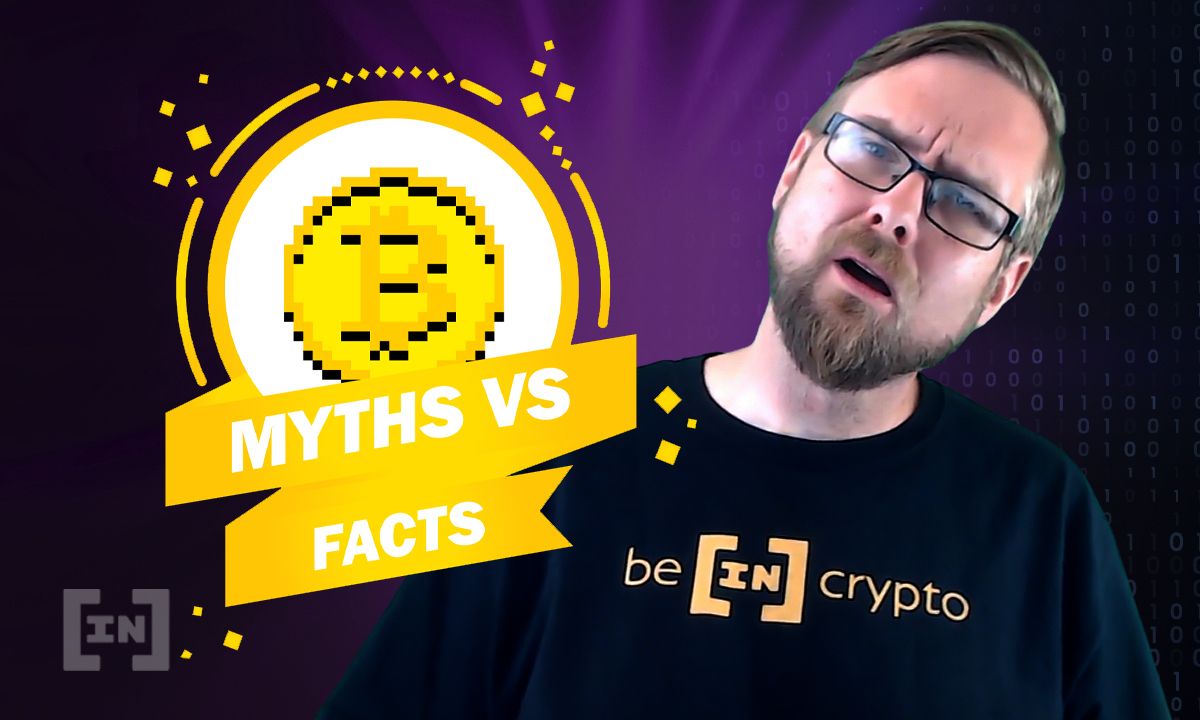BTC Myths and Facts — Common Misconceptions Dispelled
4 min readTable of Contents
In this video, BeInCrypto’s David Borman dispels some common misconceptions about BTC and other cryptocurrencies.
First, he puts BTC’s energy consumption into its proper context, before addressing the use of cryptocurrencies by criminals. Then he dispels the notion that the BTC network is hackable, and that it has no intrinsic value. He also looks at BTC’s comparison to the tulip craze or a Ponzi scheme.
BTC energy consumption
One common complaint is the amount of energy that is used to mine new bitcoins. This is a valid complaint to some extent, considering the number of computers running globally to secure the network. However, this fact alone shouldn’t invalidate BTC, especially considering the amount of energy used by other networks and institutions.
Although BTC’s carbon footprint may rival that of some countries, it pales in comparison to other legacy financial systems’ energy use. For instance, the energy usage of computer networks powering today’s international banking system far outstrips that of BTC. Although known as digital gold, BTC also uses less energy than traditional gold mining.
Although BTC accounts for a large share of cryptocurrencies’ overall market cap, many other cryptocurrencies are far more efficient in their energy use. A study from Cambridge University pointed out that 40% of cryptocurrency mining is powered by renewable energy. Tesla dropping BTC for payments due to environmental concerns will likely cause this figure to grow as well.
Used by criminals
Another common complaint is that BTC is used by criminals due to its capacity to transfer funds anonymously. Although this has certainly taken place, once again it is nowhere near the extent this happens through more traditional means. Criminal activities using cash are orders of magnitude more frequent than with BTC
Although crypto wallets are anonymous, transactions between them are immutably kept on the blockchain network on which BTC operates. This makes using them for illicit activity unwise in the longer term, as any analysis could easily track transactions made. Further investigation would also likely render the identity of certain wallet holders, especially for larger transactions.
Hacking BTC
Some BTC users also claim to have lost their funds due to security breaches, giving the impression that BTC can be hacked. However, due to the intrinsic design of the blockchain, it is infeasible that the actual network could be tampered with. Instead, what usually happens is that some method of storing a cryptocurrency can be hacked, whether exchanges or wallets.
To use a gold analogy, if gold is stolen from a vault or safe, it’s not the gold that is to blame, but rather the means in which it is kept. While the blockchain cannot be compromised, someone may get access to a wallet through its keys in the same way someone may gain access to a vault through its code.
BTC has no intrinsic value
Many have also made the claim that BTC and other cryptocurrencies lack any intrinsic value. In fact, this is also the case with today’s fiat money. For instance, the U.S. dollar used to be backed by a fixed amount of gold, which is commonly understood to have consistent intrinsic value. However, the U.S. dollar went off the gold standard in 1971, and now is backed only by global confidence in its value.
Meanwhile, BTC shares many features with precious metals that are commonly agreed to have intrinsic value. These include fixed supplies and production rates. However, BTC has the added benefit being digitally transferable across the globe, unlike precious metals.
Comparison to the tulip craze
BTC has been commonly referred to as the 21st-century version of the 17th-century tulip craze. The value of tulip bulbs as a status symbol sent prices for them skyrocketing, creating a short-term bubble. However, as production increased and investors came to their senses, the bubble eventually burst, causing many to lose small fortunes.
Although many make this claim about BTC, it is unlike the tulip phenomenon in many ways. For example, BTC represents a fundamentally better way of storing and moving value. As mentioned above, it also shares some fundamental characteristics with precious metals. Despite fluctuating speculation and volatility, BTC is unlikely to become worthless until replaced by a fundamentally superior asset.
It’s a Ponzi scheme
Another comparison frequently made is that BTC is a Ponzi, or pyramid scheme. In such schemes, people are drawn in with the promise of outsized returns, while they’re initial investment is used to pay off previous investors, leading to an unsustainable cycle of debt.
Although it may fluctuate greatly in value, causing some investors to lose large amounts of money, BTC overall is not a scheme being enacted by anyone. It’s like any other asset that gains value as more people seek to own it. Additionally, BTC’s underlying blockchain technology means that no one party can manipulate it in order to achieve the ends of some kind of nefarious plot.
The post BTC Myths and Facts — Common Misconceptions Dispelled appeared first on BeInCrypto.







